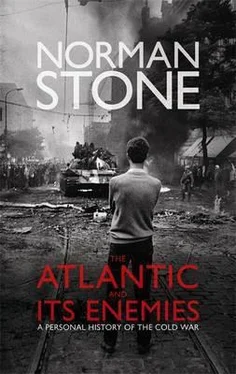But the Afghan resistance did not diminish. Rather, it grew more difficult, more anarchic, more inclined, even, to fight among itself. It was based on Pakistan and Iran, the latter maintaining Shia rebels, while in Pakistan there were 380 ‘refugee tented villages’ which maybe had the highest birth rate in the world. The seven resistance groups did not easily collaborate, and the fiercest, Hezb (Gulbuddin Hekmatyar), did not co-operate at all: it was, especially, at odds with the other chief resistance group, Massoud’s Jamiat in the Panjshir valley, and religious or tribal emphases played their part, Pakistan insisting on some sort of alliance. The Shias, with Iranian support, were not involved, and themselves were divided. But money was involved: opium from Afghanistan and the frontier areas of Pakistan supplied, in 1981-2, half of the heroin reaching the West. This is a dimension yet to be explored — or, rather, there is a serious question, as to how far the Americans were encouraging both what they later called ‘fundamentalist Islam’ and the drug trade. The CIA had been prevented, by Congress, from getting what it thought to be proper money. Why not do drugs, through Islamists who did not mind corrupting further a Christian youth whom they already regarded with contempt? At any rate, the Afghan resistance flourished, and in 1986 the Americans were giving it Stinger missiles — missiles that enabled men on mountainsides to knock out Soviet helicopters. They were brought in through Pakistan, and there was almost nothing that Moscow could do against this. The president of Pakistan himself was murdered, no doubt at Soviet behest, but this made no difference. The USSR had met its match. Thirty thousand Soviet soldiers were killed out of some 600,000 combatants — nothing, in comparison with what had happened on the Afghan side, but a vast amount, in terms of Soviet prestige.
Just as the Russians were moving into Afghanistan, and the Teheran students humiliated the American diplomats, there was a great change going on in the Atlantic world. Its origins went back to 1975, and can even be pinpointed to the Rambouillet meeting of November, that year. Disillusion with the post-war orthodoxies was growing; more and more people now thought that the answer must be to change them. Inflation? An unmitigatedly bad thing, rewarding vice and punishing virtue. Development aid? Theft. Détente? A lie. OPEC? Blackmailers. It was time to go back to the older scheme of things, of right and wrong, black and white. A little before the Rambouillet meeting, there had been a symbolic change in London: the Conservative Party disposed of its failed leader, Edward Heath, and replaced him with Margaret Thatcher. In America the old Goldwater Republicanism emerged in strength, with a new leader altogether, Ronald Reagan.
NOTE
I had my own spear-carrying experience of events in Czechoslovakia, spending three months in prison in circumstances that turned out to be quite revealing. I had gone to Vienna in 1963, on a scholarship from Cambridge, to study in the military archives. At the time, Hungary had begun to open up, and there was a month-long language school at Debrecen, where I took up with an East German girl. She had ideas of getting married and escaping to the West, and relations were not brilliant. Neither was Vienna: I spent my evenings more or less kicking a tin past the whores down the Kärntnerstrasse, though there was something to be had from one Christopher Lazare, one-time lover of Klaus Mann and author of one of the greatest book review opening lines ever: ‘John Steinbeck is an inverted Aesop; he uses human beings to illustrate animal truths.’ I had had a landlady from the Banat, who used to stir her enormous bloomers in the jam pan, and disagreed violently with me as to whether, when you cut your fingernails, the bits needed to fly off at unpredictable angles: we parted company acrimoniously, and through a Croat friend I found a splendid pair of sisters who looked after me. But it was not lively, and the next day’s newspapers were sold around 6.30 p.m., when the café waiters started looking at their watches. Lazare used to eye them and ask whether, perchance, they had the newspapers of the day after tomorrow. Budapest, even then, was more fun if you knew where to go, and I had been taken round by Adam Rez, a collaborating figure like the baron in Bulgakov, who was kindly, whereas I was hopelessly naïve: si jeunesse savait . In February 1964 I went there by train, and there followed a set of events that would be entirely familiar to anyone knowing the history of central Europe in the twentieth century (a very good introduction is Kafka’s Amerika , which is not about America at all: the whole book is a Vienna hotel). In the carriage was a Togolese studying agronomy in Romania. He had problems with the customs, and I endeavoured to translate (‘fekete ember’, etc.) as his French was all right. He had got talking to a Flemish Belgian. The Belgian opened the corridor door to a fur-coated female presence, Andrea Walder, in French. I joined the conversation, and we found things in common. She pronounced the Hungarian place names — Szekesfehérvár, etc. — correctly and I asked, sensibly, was she an academic or a journalist. She replied, ‘Je suis journaliste.’ ‘De quel journal?’ ‘Vous connaissez le Daily Express , de Londres?’ She did seven languages perfectly, and the only mistake I ever heard her make in English (she said ‘insist to’ with an infinitive rather than ‘insist on’ with a gerund: a tricky one, because all other languages do a ‘for’ with a subjunctive) was itself a bright one. She had the grand manner, could march up to any Ritz desk, order a suite, make a few telephone calls, and run away from the bill to another Ritz. Anyway I was quite bowled over. Arriving at the Eastern Station in Budapest, she introduced me to Tibor Karman, whom she described as her fiancé, and we had dinner somewhere grand (it was Communist Hungary, and the great boulevards of nineteenth-century Pest were very dimly lit, with no life at all except for sporadic uninviting shop windows, but there were still grand restaurants).
Tibor, as she presented the case, had had a horrible time. Karman is a name to conjure with, as I later discovered: one of them set up the Minta (‘Model’, meaning Teachers’ Training) school, and his son was one of the two dozen Hungarian Nobels (it is a tribute to the relationship of Hungary and the Jews that an abnormally high percentage of Hungarian Nobels were non-Jewish, namely 17.5 per cent). As I remember it, Andrea told me that Tibor’s family had had rubber plantations in Indonesia, which is quite credible. They had met, she said, during the war. Her father was a (hugely tall) Transylvanian nobleman, her mother a Viennese Jewess, and owner of a sanatorium on the Semmering, a fresh-air place for ailments, south of Vienna. The father had got the honorary consul-generalship of Monaco, and therefore flew a large neutral flag from the block on a Pest boulevard. There, when the Nazis started attacking Jews, they stuffed the house, and the Karmans must have belonged to their set. Tibor stayed there during the siege of 1945, when old Hungary collapsed. Communists took over, and were no more friends of the Rózsadomb Jews than the Nazis had been. He was then, she said, imprisoned by the Communists and tortured. There were nasty marks on his back. He had been held in Szolnok, and therefore not released in 1956, because it was under Russian control, but he had met János Kádár in prison, and played chess with him, and Kádár had let him out. Then he had been given the sort of job — hospital portering — that released prisoners got. He had, in the evenings, betaken himself to old haunts, the Grand Hotel on the Margaret Island, where the barmen and the waiters were all part of old Hungary. Foreign journalists ended up there. Andrea, escaping from writs from the Ritz, ended up there as well, reporting for RIAS in Berlin (the Daily Express was I suspect something of a fantasy, but she had had some sort of affair with a married English peer in London, whose photograph, of him on a horse, she kept by her bedside). She and Tibor met in that red plush and gold bar. It was Ortrud and Telramund. There was money, once the West was reached. The West Germans were offering compensation for the horrors of 1944. More: there was a Herr Generaldirektor in Vienna to whom, as an SS officer, the Karmans had entrusted property, in particular some Dutch paintings, and he had deposited them for safe-keeping in the national bank of the then Independent State of Croatia, in Zagreb. That Herr Generaldirektor would have some explaining to do. They would get married. They went to the Hungarian government and asked for an exit visa — refused. What they needed was a useful idiot, der Geist, der stets bejaht . And she met me on that train.
Читать дальше












![Edward Ellis - Adrift on the Pacific - A Boys [sic] Story of the Sea and its Perils](/books/753342/edward-ellis-adrift-on-the-pacific-a-boys-sic-s-thumb.webp)